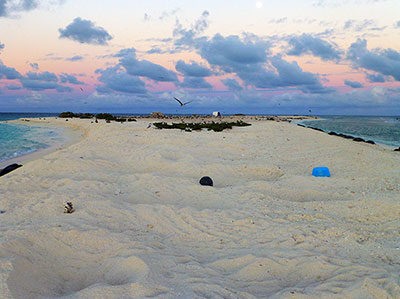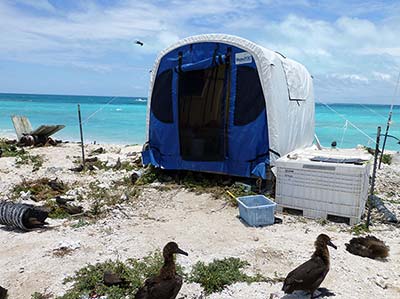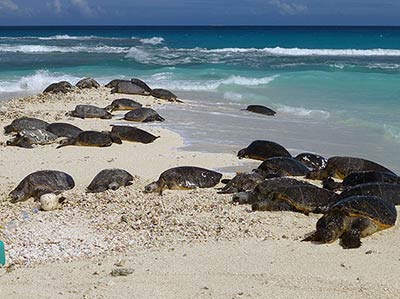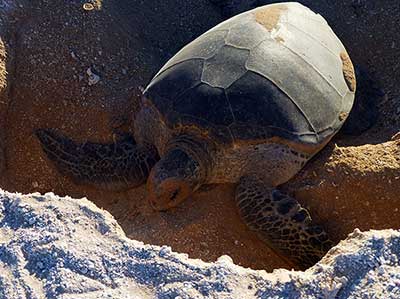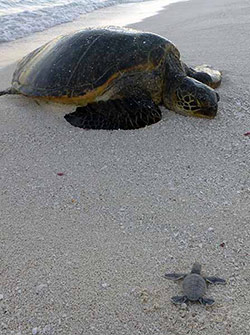Monitoring Sea Turtles by Moonlight
Picture this - you are freshly out of college and you take a field research assignment where you are transported by ship to a remote coral atoll in the Hawaiian Archipelago, several hundred miles from any civilization, dropped off, and tasked with monitoring sea turtle nesting activity at night. Your accommodations are primitive, and you will share the tiny island with tens of thousands of noisy, smelly seabirds, monk seals, and, of course, sea turtles. Oh, did we also mention the waters surrounding the island are full of hungry tiger sharks coming for their annual fledgling albatross feast? You will have no cell phone, no Internet, no TV, just you and the wildlife. You will also be alone.
Such was the mission taken by recent Pitzer College Environmental Policy graduate Emma Gosliner as part of an ongoing (42 years in 2015) sea turtle monitoring project run by NOAA’s Pacific Island Fishery Science Center’s Protected Species Division.
Emma was not totally alone. On a nearby islet several miles across the atoll, which is part of the U.S. Fish and Wildlife Service Hawaiian Islands National Wildlife Refuge, four Hawaiian monk seal researchers, also with NOAA, were camped. They would come every few days by small boat when the weather cooperated to check on her and do their own monitoring on the endangered Hawaiian monk seal population across French Frigate Shoals. They would bring her back every fourth day to the primitive camping on Tern Island and she monitored turtles there for four days before returning to East Island. Emma did this for 2 ½ months, from mid-May to July 31 when we picked her up on NOAA Ship Hiʻialakai to join the 2015 Reef Assessment and Monitoring Program expedition.
East Island has the highest density of green sea turtle nesting sites in the entire Hawaiian Archipelago. More than 90% of all Hawaiian green sea turtles come from nests on this tiny 11-acre island. If you happen to see a green sea turtle anywhere in the main Hawaiian Islands while snorkeling, diving, or hauled out on a beach, nine out of 10 times that turtle came from this tiny island more than 500 miles from Oʻahu.
Green sea turtles can live more than 40 years, yet do not reach sexual maturity until 20-25 years of age when they come to the this remote atoll to breed and lay their eggs. They have to travel this far because there are few safe places for them to nest in the main Hawaiian Islands where shoreline disturbance, human uses of beaches, and abundance of egg predators such as cats, dogs and mongooses prevent successful nesting.
Last year, the highest density of green sea turtle nesting was recorded at East Island since the monitoring program began in 1973. Less than 100 nesters were recorded in 1973, and in 2014, 818 nesting turtles were recorded. This year, Emma recorded about 500 nesters at East Island, though she is still putting together her final report. Recorded nesting density has followed a pattern over the last forty years of increasing for three to four years, reaching a peak, and then diminishing again, but the trend has been jerkily upward since the study began. These low-lying islands are only a few feet above sea level and are threatened by rising sea levels from a warming planet. At some point, the diminished amount of available safe area for nesting Hawaiian green sea turtles will limit successful nesting. If the islands disappear beneath the waves so too will Hawaiian green sea turtles unless other suitable nesting sites can be established.
Hawaiian green sea turtles were protected under Hawaiʻi State Law in 1974, and were listed as a threatened species under the Endangered Species Act in 1978. These protections came through the diligent efforts of primarily one man, Dr. George Balazs, who continues to lead the Turtle Research Division at NOAA’s Pacific Islands Fishery Science Center to this day and is a passionate advocate for sea turtles worldwide.
Young Emma works under Dr. Balazs and had the opportunity to validate much of his sage field advice gained through many years working with sea turtles. One bit of advice that surprised her was the use of eye protection and knee pads! All of the monitoring Emma conducted was at night, between 9 PM and 5 AM in the morning, and a small sandy island covered in large sea turtles weighing up to 350 lbs looking for places to nest and digging holes presents strange hazards. Imagine walking across a sandy, deeply cratered field in the dark, with large roving speed bumps crossing your path and occasionally stopping to dig nest pits and fling sand, coral rubble, and even marine debris at you. It sounds like a great video game, but for Emma this was her life for 2 ½ months, and she can personally attest that being hit with a flying bottle off a powerful front flipper hurts! Good thing she had that eye protection.
Each night Emma was tasked with counting the nesting turtles and nests, measuring shell length with long calipers, looking for metal flipper tags or scanning for embedded pit tags that identify each previously tagged animal, and recording other turtle activity. She was equipped with a really cool 20-pocket vest for all her tools, spray paint for marking turtles, an etching tool for recording ID numbers on shells, wire cutters, data logging books, and of course a headlamp with a red filter to improve night vision and not disturb the animals. She slept in a tent without shade during the hot days and worked at night, and if you are imagining a peaceful quiet you have forgotten about the thousands of seabirds that also nest on and under every surface of the island and make constant noise night and day. Emma says that her college days living in the dorms well prepared her for the heat, noise and smell of living on island with lots of wildlife and she did not have problems sleeping.
One of the high points for Emma was watching a turtle nest erupt with fifty hatchlings during one of her evening monitoring walks. She said it looked like a group of young kids playing soccer - just total chaos with turtle hatchlings spreading in every direction. Fortunately, on small East Island there is no wrong way to the sea. She also got to see several amazing meteor showers and incredible stars on moonless nights. Another highlight was watching tiger sharks come in to feed on fledgling albatross that had the misfortune of landing in the lagoon during their first flight, though it was a bit intimidating that they would come in at the same place she used to bathe!
What did Emma look forward to most after 2 ½ months on a tropical desert island? A real shower!
Return to RAMP Expedition Log.
